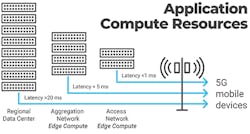5G Requires Smarter Network Data Insights
With fifth generation (5G) networks ramping up, network operators and subscribers alike are expecting improvements in wireless performance and overall customer experience. Many subscribers today use 4G/LTE networks, first introduced to the public in 2009. It makes sense why many are so excited for this new service to be publicly available everywhere (though, that will take time especially for rural Americans) — 5G is promising a number of improvements.
Mobile Network Operators (MNO) are promising many benefits, including faster speed, shorter delays (i.e., lower latency), and increased connectivity. The fifth generation of mobile networks is expected to be 10 times faster than 4G, and to support connectivity for up to 1 million mobile devices per square kilometer, theoretically allowing many co-located users to simultaneously connect seamlessly with multiple high-speed devices at one time. Importantly, 5G has the potential to greatly reduce the latency common in today’s cellular networks.
InvisiLight® Solution for Deploying Fiber
April 2, 2022Go to Market Faster. Speed up Network Deployment
April 2, 2022Episode 10: Fiber Optic Closure Specs Explained…
April 1, 2022Food for Thought from Our 2022 ICT Visionaries
April 1, 2022While the hype for 5G is at a boiling point, its promise to increase bandwidth while also greatly reducing networking delays has made the hype warranted for many subscribers: both individual mobile broadband consumers, and businesses with industrial IoT applications. Lower latency will enable subscribers to do completely new things, far and beyond just increasing the bandwidth capacity for the things we can do now.
IoT and Latency
Latency is the delay from one end of an application connection to the other, and is a measure of time — milliseconds for most communications applications. Network capacity, what we might often refer to as bandwidth, is a quantity of bits measured over a fixed time interval: megabits per second in the context of 5G. Many applications, like streaming online video, need lots of capacity but are generally not impacted by network delay. Other applications, like voice calls, don’t use much bandwidth but are delay-sensitive. 5G will enable mobile applications that require both low latency and high bandwidth.
Figure 1. Distance between application compute resources and 5G device determines minimum latency.
Latency can cause major headaches for users, especially for IoT applications and devices. Analysts estimate that by 2020 there will be more than 20 billion IoT devices installed around the world, generating enormous amounts of data. While "IoT" may recall images of Wi-Fi-enabled video doorbells and smart lightbulbs, currently, many industrial IoT devices use cellular networks like 4G LTE to connect back to the data center where the IoT controller is located. Limited wireless network capacity coupled with far-distant data centers results in a large volume of data being transported to and from the billions of IoT devices, incurring undesirable latency for the applications. With an increasing number of devices on current networks, we’ll see increased congestion and increased latency issues.
5G reduces network latency in 2 ways. First, 5G adds wireless network capacity (i.e., Mbps), allowing more applications to transmit data at their "full throttle" maximum speed. More capacity reduces congestion and thus eliminates undesirable packet retransmission delay. For some applications, even transmitting data at the maximum rate will still result in too much latency — too much time delay. 5G does not change the speed of light, and so the only way to reduce latency between the 5G device and the data center hosting the application is to move the data center closer to the device as shown in Figure 1. While it may seem like cheating, this is the goal of edge computing: move the application from the data center to the edge of the network to reduce the round-trip delay, and to eliminate the need to pay for needless transport.
Figure 2. 5G RAN densification drives innovation in fiber access networks.
Who and what will see the biggest returns from lower latency? You don’t have to look any further than the mobile broadband user who will indulge in online multiplayer gaming, augmented and virtual reality, immersive entertainment, and real-time video sharing — all while they venture away from their home Wi-Fi broadband connections.
But the real benefits of 5G’s lower latency, and the biggest impact to society, will come from industrial IoT applications in what many refer to as the Fourth Industrial Revolution. The vision of 5G industrial IoT is that everything that can be connected will be. Every smartphone, car, sensor, robot, street sign, medical device, outdoor light, cargo container, electric meter, and so on, without boundaries to the limit of our imagination. It’s a long-term vision, and will be coupled with transformative technologies like edge computing, artificial intelligence, and machine learning.
Prepping for 5G
While 5G is available in a handful of US cities at the moment, the majority of the country’s inhabitants won’t experience the new technology for several years — and very-high-speed, low-latency 5G will follow even later. 5G mobile networks will be made up of both sub-6 GHz spectrum and "greater than 6Hz" millimeter wavelength (mmWave) spectrum, together providing the just right mix of coverage, latency, and capacity, for the emerging 5G mobile, fixed access, and industrial IoT, applications.
Why both? Sub-6 Ghz spectrum is the same spectrum used today to deliver LTE mobile broadband. It has great propagation characteristics, so a single high-power LTE macro cell site can cover a large area. But even if we include the new mid-band 3-4 GHz spectrum for 5G, the capacity increase over LTE won’t be dramatic — doubling at best. The highest speed 5G (1-10 Gbps) requires use of high-frequency mmWave spectrum, which is great for capacity but only over very short ranges — less than 300 meters is commonly claimed. The benefits from very-high-speed 5G will require access to mmWave spectrum, lots of 5G small cell sites, and lots of fiber — all of which will require enormous investment. Better start preparing now.
Building a 5G network is a complex undertaking and can’t be trivialized. From a transport perspective there are only 2 routes to take as MNOs light up 5G networks:
1. Throw fiber at the problem to deliver a short-term expensive Radio Access Network (RAN) transport solution.
2. Build a low-cost distributed fiber access network that will scale 5G (and LTE) RAN densification for the long-term.
We can expect that MNOs will do both, realizing that an inefficient fiber transport network will result in run-away costs as the density of 5G small cells increases. Fortunately, industry groups and standards bodies are working to optimize the use of highly efficient point-to-multipoint technologies — namely, 10G PON (as shown in Figure 2) and DOCSIS HFC networks — for 5G transport. 5G small cell aggregation may be a daunting problem for a traditional transport network, but it is child’s play for these technologies already optimized to deliver gigabit speeds to every home.
Along with fiber transport efficiencies, MNOs — and all other communication service providers — are investing in tools that provide insight into usage patterns and subscriber behavior. The power of analytics doesn’t necessarily depend on the volume of data, but rather the variety of data types, and when and how they are used. Diverse types of information, when correlated, provide better insights for network capacity planning, service tier optimization, churn prediction, and network automation, to accommodate dynamic service demands.
Insights From Diverse Data
We understand the importance of data. Analytics platforms enables CSPs to mine subscriber behavior and network data to understand the needs of individual subscribers, so they can invest when and where there is actual demand for specific services. Through analytic services like the Calix Cloud, providers can identify power users and traffic patterns in specific locations. With the emergence of a 5G "everything that can be connected will be" world, diving deeper and analyzing more data to automate network operations and to deliver an exceptional subscriber experience will be more important than ever.
Mobile broadband use continues to climb globally — a predicted 46% average global growth over the next 5 years fueled by the massive increase in video consumption (Cisco Visual Networking Index: Forecast and Trends, 2017–2022). Broadband consumption levels will test the boundaries of existing LTE networks, forcing MNOs to seek more spectrum, denser radio networks, and more fiber. While MNOs have been densifying the RAN with LTE small cells to keep up with data consumption, this is a temporary solution. High-capacity 5G small cell networks will be required to keep pace with overall demand.
The 5G network evolution is also an "insight revolution." Unlike the wireless network evolutions of the past, which were primarily intended to increase wireless data capacity, the 5G network evolution increases capacity and paves the way to deliver a whole new set of mobile applications. Insights from a diverse data set are needed to target and dynamically deliver these new services to mobile users and industrial applications.
In order to have a successful 5G rollout, MNOs, platform and systems suppliers, and industry groups, must push the limits of innovation to deliver comprehensive end-to-end solutions. An inundation of network and service insights must accompany high-density 5G small cell aggregation solutions that are fiber-efficient, high-capacity, low-cost, low-power, easy to install, and simple to operate. Only time will tell, but we’re off to a good start.
Like this Article?
Subscribe to ISE magazine and start receiving your FREE monthly copy today!
Reference
Cisco Visual Networking Index: Forecast and Trends, 2017–2022 White Paper. Updated February 27, 2019. Document ID:1551296909190103. Cisco. https://www.cisco.com/c/en/us/solutions/collateral/service-provider/visual-networking-index-vni/white-paper-c11-741490.html
About the Author







